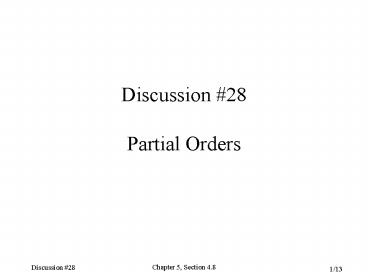Discussion - PowerPoint PPT Presentation
1 / 13
Title:
Discussion
Description:
Hasse diagrams. Bounded and well-founded posets. Discussion #28. Chapter 5, Section 4.8 ... In a Hasse diagram, every element with no element 'above' it is a maximal ... – PowerPoint PPT presentation
Number of Views:41
Avg rating:3.0/5.0
Title: Discussion
1
Discussion 28Partial Orders
2
Topics
- Weak and strict partially ordered sets (posets)
- Total orderings
- Hasse diagrams
- Bounded and well-founded posets
3
Partial Orders
- Total orderings single sequence of elements
- Partial orderings some elements may come
before/after others, but some need not be ordered - Examples of partial orderings
must be completed before
set inclusion, ?
4
Partial Order Definitions(Poset Definitions)
- A relation R S?S is called a (weak) partial
order if it is reflexive, antisymmetric, and
transitive.
e.g. ? on the integers
e.g. lt on the integers
- A relation R S?S is called a strict partial
order if it is irreflexive, antisymmetric, and
transitive.
5
Total Order
- A total ordering is a partial ordering in which
every element is related to every other element.
(This forces a linear order or chain.) - Examples
1 2 3 4 5
R ? on 1, 2, 3, 4, 5 is total. Pick any two
theyre related one way or the other with respect
to ?.
R ? on a, b, a, b, ? is not total. We
can find a pair not related one way or the other
with respect to ?. a b neither a ? b
nor b ? a
a,b
a
b
?
6
Hasse Diagrams
- We produce Hasse Diagrams from directed graphs
of relations by doing a transitive reduction plus
a reflexive reduction (if weak) and (usually)
dropping arrowheads (using, instead, above to
give direction) - 1) Transitive reduction ? discard all arcs except
those that directly cover an element. - 2) Reflexive reduction ? discard all self loops.
For ?
we write
a, b
?
b
a
?
7
Descending Sequence
- Descending sequence A sequence ltx1, x2, , xngt
where for i lt j, xi is strictly above xj on a
path in a Hasse diagram xi need not, however, be
immediately above xj. - Examples
- ? lta,b,c, c, ? gt descending
- lta,b,c, b, c, ? gt not descending
- lta,b,c, b,c, c, ? gt descending
- ? lt5, 4, 2gt descending
- lt3, 2, 2, 2, 1gt not descending
8
Well Founded Poset
- A poset is well founded if it has no infinite
descending sequence. - Examples
- gt on the integers?
- lt3, 2, 1, 0, -1, gt not well founded
- on finite sets?
- lta, b, c, c, ?gt well founded
- All finite strict posets are well founded.
- ? on finite sets?
- lta, a, a, gt not a descending sequence
- All finite (weak) posets are well founded.
- gt natural numbers?
- lt, 3, 2, 1, 0gt infinite, but well founded
9
Application of Well Founded Posets
- Has anyone ever gotten into an infinite loop in a
program? - We use well founded sets to prove that loops
terminate. - e.g. The following clearly terminates.
- for i1 to n do
- n?i for i1, , n is a descending sequence on
a well founded set (the natural numbers) ltn?1,
n?2, , n?n 0gt.
10
More Interesting Termination Example
- S ? Ax
- S ? Cy
- D ? zE
- E ? x
- A ? SB
- B ? y
- C ? z
//Reachable in a grammar S' ? S rule s
of start symbol while S gt S' S' S
S S' ? rule s of rhs non-ts
rules ? S'
well founded no infinite descending sequence no
matter what grammar is input.
11
Upper and Lower Bounds
- If a poset is built from relation R on set A,
then any x ? A satisfying xRy is an upper bound
of y, and any x ? A satisfying yRx is a lower
bound of y. - Examples If A a, b, c and R is ?, then a,
c - - is an upper bound of a, c, and ?.
- - is also an upper bound of a, c (weak poset).
- - is a lower bound of a, b, c.
- - is also a lower bound of a, c (weak poset).
12
Maximal and Minimal Elements
- If a poset is built from relation R on set A,
then y ? A is a maximal element if there is no x
such that xRy, and x ? A is a minimal element if
there is no y such that xRy. (Note We either
need the poset to be strict or x ? y.) - In a Hasse diagram, every element with no element
above it is a maximal element, whereas every
element with no element below it is a minimal
element.
Maximal elements
Minimal elements
13
Least Upper and Greatest Lower Bounds
- A least upper bound of two elements x and y is a
minimal element in the intersection of the upper
bounds of x and y. - A greatest lower bound is a maximal element in
the intersection of the lower bounds of x and y. - Examples
- For ?, a, c is a least upper bound of a and
c, - ? is a greatest lower bound of a and b, c,
and - a is a least upper bound of a and ?.
- For the following strict poset, lub(x,y) a,b,
lub(y,y) a,b,c, lub(a,y) ?, glb(a,b)
x,y, glb(a,c) y
a
b
c
x
y































